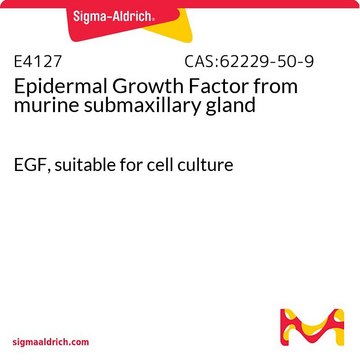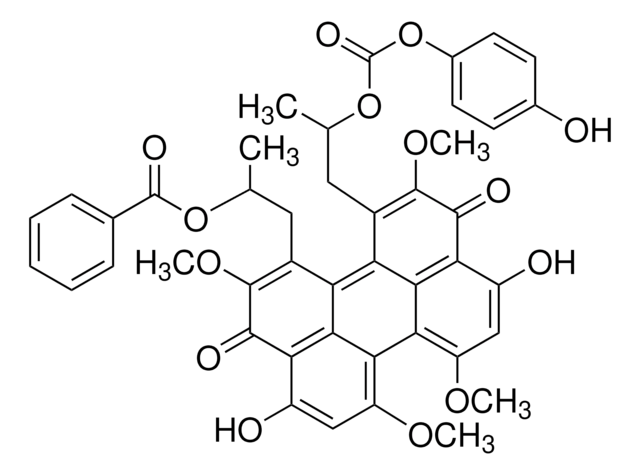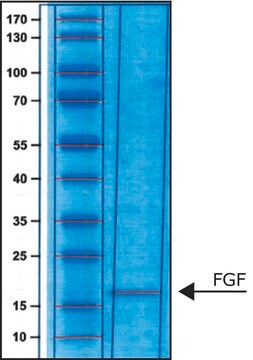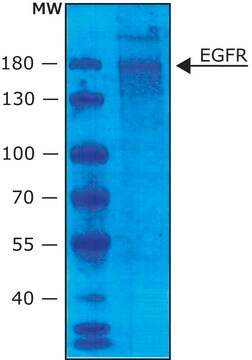E5036
Epidermal Growth Factor Protein, human
>97% (SDS-PAGE), recombinant, expressed in E. coli, lyophilized powder, suitable for cell culture
Sinônimo(s):
EGF
About This Item
Produtos recomendados
product name
Fator de crescimento epidérmico, EGF, recombinant, expressed in Escherichia coli, >97% (SDS-PAGE)
fonte biológica
human
Nível de qualidade
recombinante
expressed in E. coli
Ensaio
>97% (SDS-PAGE)
forma
lyophilized powder
potência
0.08-0.8 ng/mL EC50
peso molecular
~6 kDa
embalagem
pkg of 200 and 500 μg
condição de armazenamento
avoid repeated freeze/thaw cycles
Impurezas
≤1 EU/μg Endotoxin
cor
white
solubilidade
water: soluble 0.190-0.210, clear, colorless
nº de adesão UniProt
temperatura de armazenamento
−20°C
Informações sobre genes
human ... EGF(1950)
Procurando produtos similares? Visita Guia de comparação de produtos
Descrição geral
Aplicação
- as a supplement in in LHC-8 medium to culture liver cell lines
- in the fetal bovine serum (FBS)-Dulbecco′s modified essential medium (DMEM) /F12 medium for primary culture of human glioma cells
- as an additive in the conditional medium of normal fibroblasts (NFs) to study its effect on the migration and invasion of endometrial cancer (EC) cells
- as a component in tumorsphere medium
Ações bioquímicas/fisiológicas
Citação
2. Gregory, H., Isolation and structure of urogastrone and its relationship to epidermal growth factor. Nature, 257, 325-327 (1975).
3. George-Nascimento, C. et al., Characterization of recombinant human epidermal growth factor produced in yeast. Biochemistry, 27, 797-802 (1988).
4. Todaro, G.J. et al., Transforming growth factors produced by certain human tumor cells: polypeptides that interact with epidermal growth factor receptors. Proc. Natl. Acad. Sci. USA, 77, 5258-5262 (1980).
5. Blomquist, M.C. et al., Vaccinia virus 19-kilodalton protein: relationship to several mammalian proteins, including two growth factors. Proc. Natl. Acad. Sci. USA, 81, 7363-7367 (1984).
6. Eppstein, D.A. et al., Epidermal growth factor receptor occupancy inhibits vaccinia virus infection. Nature, 318, 663-665 (1985).
Código de classe de armazenamento
13 - Non Combustible Solids
Classe de risco de água (WGK)
WGK 2
Ponto de fulgor (°F)
Not applicable
Ponto de fulgor (°C)
Not applicable
Certificados de análise (COA)
Busque Certificados de análise (COA) digitando o Número do Lote do produto. Os números de lote e remessa podem ser encontrados no rótulo de um produto após a palavra “Lot” ou “Batch”.
Já possui este produto?
Encontre a documentação dos produtos que você adquiriu recentemente na biblioteca de documentos.
Os clientes também visualizaram
Nossa equipe de cientistas tem experiência em todas as áreas de pesquisa, incluindo Life Sciences, ciência de materiais, síntese química, cromatografia, química analítica e muitas outras.
Entre em contato com a assistência técnica











